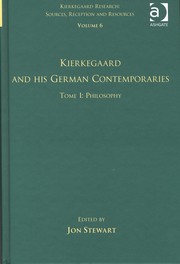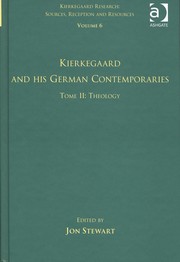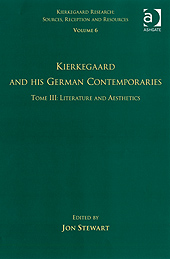

|

Volume 6:
Kierkegaard and his German Contemporaries
Edited by
Jon Stewart
This volume explores in detail Kierkegaard’s various relations
to his German contemporaries. Kierkegaard read German fluently
and made extensive use of the writings of German-speaking
authors. It can certainly be argued that, apart from his
contemporary Danish sources, the German sources were probably
the most important in the development of his thought generally.
This volume thus represents source-work research dedicated to
tracing Kierkegaard’s readings and use of the various
German-speaking authors in the different fields. The goal has
been in the first line to trace these influences in a way that
is as clearly documented as possible.
The volume has been divided into three tomes reflecting
Kierkegaard’s main areas of interest with regard to the
German-speaking sources, namely, philosophy, theology and a more
loosely conceived category, which has here been designated
“literature and aesthetics.”
Tome I:
Philosophy
The first tome treats the German philosophical influences on Kierkegaard.
The dependence of Danish philosophy on German philosophy is beyond question.
In a book review in his Hegelian journal Perseus,
the poet, playwright and critic, Johan Ludvig Heiberg laments the sad
state of philosophy in Denmark, while lauding German speculative
philosophy. Moreover, Kierkegaard’s lifelong enemy, the theologian Hans
Lassen Martensen claims without exaggeration that the Danish systems of
philosophy can be regarded as the “disjecta membra” of earlier German systems. All of the
major German idealist philosophers made an impact in Denmark: Kant, Fichte,
Schelling, and most significantly, Hegel. Kierkegaard was widely read in the
German philosophical literature, which he made use of in countless ways
throughout his authorship.
Table of Contents
Baader:
The
Centrality of Original Sin and the Difference of Immediacy
and Innocence
Peter Koslowski
Bayer: Kierkegaard’s Attempt at Social Philosophy: An
Examination of Kierkegaard’s Relationship to Karl Bayer
J. Michael Tilley
Feuerbach: A Malicious Demon in the Service of
Christianity
István Czakó
I.H. Fichte: Philosophy as the Most Cheerful Form of
Service to God
Hartmut Rosenau
J.G. Fichte: From Transcendental Ego to Existence
David J. Kangas
Hegel: Kierkegaard’s Reading and Use of Hegel’s
Primary Texts
Jon Stewart
Herder: A Silent Background and Reservoir
Johannes Adamsen
Kant: A Debt both Obscure and Enormous
Ronald M. Green
Lichtenberg: Lichtenberg’s Aphoristic Thought and Kierkegaard’s Concept
of the “Subjective Existing Thinker”
Smail Rapic
Schelling: A Historical Introduction to Kierkegaard’s
Schelling
Tonny Aagaard Olesen
Schopenhauer: Kierkegaard’s Late Encounter with His
Opposite
Simonella Davini
Schubert: Kierkegaard’s Reading of Gotthilf Heinrich
Schubert’s Philosophy of Nature
Stefan Egenberger
Trendelenburg: An Ally against Speculation
Darío González
Werder: The Influence of Karl Werder’s Lectures and
Logik on Kierkegaard’s Thought
Jon Stewart
Tome II: Theology
The second tome of the present volume is dedicated to Kierkegaard’s main
theological influences. In theology as well, the German and the Danish
traditions had long been closely connected via their common source: Luther.
In Kierkegaard’s time the main influence on theology was probably German
philosophy and specifically Hegelianism. Most all of the German theologians
were in some way in a critical dialogue with this movement. Another
important influence was Schleiermacher, who visited Copenhagen in 1833 and
was important for several Golden Age thinkers. From his student days
Kierkegaard kept abreast of the German theological literature, from which he
drew much inspiration.
Table of Contents
Bruno
Bauer: Biblical Narrative, Freedom and Anxiety
David James and Douglas Moggach
F.C. Baur: On the Similarity and Dissimilarity
between Jesus and Socrates
David D. Possen
K.G. Bretschneider: The Tangled Legacy of Rational
Supernaturalism
Lee C. Barrett
Carl Daub: Kierkegaard’s Appropriation of a Hegelian
Sentry
Jon Stewart
Erdmann: Appropriation and Criticism, Error and
Understanding
Stephan Bitter
Günther: Kierkegaard’s Use of an Austrian Catholic
Theologian
Christoph Kronabel and Jon Stewart
Marheineke: The Volatilization of Christian Doctrine
Heiko Schulz
Julius Müller: Parallels in the Doctrines of Sin and
Freedom in Kierkegaard and Müller
Christine Axt-Piscalar
Rosenkranz: Traces of Hegelian Psychology and
Theology in Kierkegaard
Heiko Schulz
Schleiermacher: Revisiting Kierkegaard’s Relationship
to Him
Richard E. Crouter
D.F. Strauss: Kierkegaard and Radical
Demythologization
George Pattison
Tome III: Literature and Aesthetics
This third tome is dedicated to the German literary sources that were
significant for Kierkegaard. These articles feature primarily important
authors from German Classicism and Romanticism. Important forerunners for
many of Kierkegaard’s literary motifs and characters can be found in the
German literature of the day. His use of pseudonyms and his interest in
irony were both profoundly influenced by German Romanticism. Moreover, many
of Kierkegaard’s views on criticism and aesthetics were decisively shaped by
the work of German authors.
Table of Contents
Achim von
Arnim: Kierkegaard’s Encounters with a Heidelberg Hermit
Judith Purver
Eichendorff: Kierkegaard’s Reception of a German
Romantic
Judith Purver
Goethe: A German Classic Through the Filter of the
Danish Golden Age
Jon Stewart and Katalin Nun
Hamann: Sharing Style and Thesis: Kierkegaard’s
Appropriation of Hamann’s Work
Sergia Karen Hay
E.T.A. Hoffmann: A Source for Kierkegaard’s
Conceptions of Authorship, Poetic-Artistic Existence, Irony
and Humor
Judit Bartha
Hotho: A Dialogue on Romantic Irony and the
Fascination with Mozart’s Don Giovanni
Joachim Grage
Jean Paul: Apparent and Hidden Relations between
Kierkegaard and Jean Paul
Markus Kleinert
Schiller: Kierkegaard’s Use of a Paradoxical Poet
András Nagy
Friedrich Schlegel: On Ironic Communication,
Subjectivity and Selfhood
K. Brian Söderquist
Solger: An Apostle of Irony Sacrificed to Hegel’s
System
Jon Stewart
Tieck: Kierkegaard’s “Guadalquivir” of Open Critique
and Hidden Appreciation
Marcia C. Robinson
|
Kierkegaard and the Bible,
Tomes I-II

Kierkegaard and the
Greek World,
Tomes I-II

Kierkegaard and the
Roman World

Kierkegaard and the
Patristic and
Medieval Traditions

Kierkegaard and the
Renaissance and
Modern Traditions,
Tomes I-III

Kierkegaard and his
German Contemporaries,
Tomes I-III

Kierkegaard and his
Danish Contemporaries,
Tomes I-III
|
The
series Kierkegaard Research: Sources,
Reception and Resources is published Routledge Research, Philosophy
Routledge / Taylor & Francis Group, 711 Third Ave., Eighth Floor, New York, NY 10017, USA
Jon Stewart©2007-2020
|















